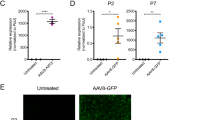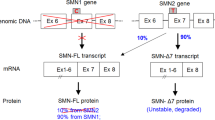Abstract
Charcot-Marie-Tooth (CMT) disease, also known as hereditary motor sensory neuropathy, is a group of rare genetically heterogenous diseases characterized by progressive muscle weakness and atrophy, along with sensory deficits. Despite extensive pre-clinical and clinical research, no FDA-approved therapy is available for any CMT type. We previously identified C1ORF194, a novel causative gene for CMT, and found that both C1orf194 knock-in (I121N) and knockout mice developed clinical phenotypes similar to those in patients with CMT. Encouraging results of adeno-associated virus (AAV)-mediated gene therapy for spinal muscular atrophy have stimulated the use of AAVs as vehicles for CMT gene therapy. Here, we present a gene therapy approach to restore C1orf194 expression in a knockout background. We used C1orf194-/- mice treated with AAV serotype 9 (AAV9) vector carrying a codon-optimized WT human C1ORF194 cDNA whose expression was driven by a ubiquitously expressed chicken β-actin promoter with a CMV enhancer. Our preclinical evaluation demonstrated the efficacy of AAV-mediated gene therapy in improving sensory and motor abilities, thus achieving largely normal gross motor performance and minimal signs of neuropathy, on the basis of neurophysiological and histopathological evaluation in C1orf194-/- mice administered AAV gene therapy. Our findings advance the techniques for delivering therapeutic interventions to individuals with CMT.







Similar content being viewed by others
References
Hattori N, Yamamoto M, Yoshihara T, Koike H, Nakagawa M, Yoshikawa H, et al. Demyelinating and axonal features of Charcot–Marie–Tooth disease with mutations of myelin-related proteins (PMP22, MPZ and Cx32): a clinicopathological study of 205 Japanese patients. Brain. 2003;126:134–51.
Berciano J, García A, Gallardo E, Peeters K, Pelayo-Negro AL, Álvarez-Paradelo S, et al. Intermediate Charcot–Marie–Tooth disease: an electrophysiological reappraisal and systematic review. J Neurol. 2017;264:1655–77.
Sun S-C, Ma D, Li M-Y, Zhang R-X, Huang C, Huang H-J, et al. Mutations in C1orf194, encoding a calcium regulator, cause dominant Charcot-Marie-Tooth disease. Brain. 2019;142:2215–29.
Huang C, Shen ZR, Huang J, Sun SC, Ma D, Li MY, et al. C1orf194 deficiency leads to incomplete early embryonic lethality and dominant intermediate Charcot–Marie–Tooth disease in a knockout mouse model. Hum Mol Genet. 2020;29:2471–80.
Berciano J, García A, Combarros O. Initial semeiology in children with Charcot-Marie-Tooth disease 1A duplication: CMT-1A Initial Semeiology. Muscle Nerve. 2003;27:34–9.
Krajewski K, Lewis R, Fuerst D, Turansky C, Hinderer S, Garbern J, et al. Neurological dysfunction and axonal degeneration in Charcot-Marie-Tooth disease type 1A. J Peripher Nerv Syst. 2001;6:61–61.
Bird TD. Charcot-Marie-Tooth hereditary neuropathy overview. University of Washington, Seattle, 2022. https://www.ncbi.nlm.nih.gov/books/NBK1358/. (Accessed 13 Jan 2023).
Morena J, Gupta A, Hoyle JC. Charcot-Marie-Tooth: from molecules to therapy. Int J Mol Sci. 2019;20:3419.
Padua L, Aprile I, Cavallaro T, Commodari I, La Torre G, Pareyson D, et al. Handgrip impairment in Charcot-Marie-Tooth disease. Eura Medicophys. 2006;27:417–23.
Sman AD, Hackett D, Fiatarone Singh M, Fornusek C, Menezes MP, Burns J. Systematic review of exercise for Charcot-Marie-Tooth disease. J Peripher Nerv Syst. 2015;20:347–62.
Guyton GP. Orthopaedic aspects of Charcot-Marie-Tooth disease. Foot Ankle Int. 2006;27:1003–10.
Chan G, Bowen JR, Kumar SJ. Evaluation and treatment of hip dysplasia in Charcot-Marie-Tooth disease. Orthop Clin North Am. 2006;37:203–9.
Corrado B, Ciardi G, Bargigli C. Rehabilitation management of the Charcot–Marie–Tooth syndrome. Medicine (Baltimore). 2016;95: e3278.
Kenis-Coskun O, Matthews DJ. Rehabilitation issues in Charcot-Marie-Tooth disease. J Pediatr Rehabil Med. 2016;9:31–4.
Mendell JR, Al-Zaidy S, Shell R, Arnold WD, Rodino-Klapac LR, Prior TW, et al. Single-dose gene-replacement therapy for spinal muscular atrophy. N Engl J Med. 2017;377:1713–22.
White KA, Nelvagal HR, Poole TA, Lu B, Johnson TB, Davis S, et al. Intracranial delivery of AAV9 gene therapy partially prevents retinal degeneration and visual deficits in CLN6-Batten disease mice. Mol Ther - Methods Clin Dev. 2021;20:497–507.
Mendell JR, Al-Zaidy SA, Lehman KJ, McColly M, Lowes LP, Alfano LN, et al. Five-year extension results of the phase 1 START trial of onasemnogene abeparvovec in spinal muscular atrophy. JAMA Neurol. 2021;78:1–8.
Mendell JR, Sahenk Z, Lehman K, Nease C, Lowes LP, Miller NF, et al. Assessment of systemic delivery of rAAVrh74.MHCK7.micro-dystrophin in children with Duchenne muscular dystrophy. JAMA Neurol. 2020;77:1–10.
Wang D, Zhong L, Nahid MA, Gao G. The potential of adeno-associated viral vectors for gene delivery to muscle tissue. Expert Opin Drug Deliv. 2014;11:345–64.
Bish LT, Morine K, Sleeper MM, Sanmiguel J, Wu D, Gao G, et al. Adeno-associated virus (AAV) serotype 9 provides global cardiac gene transfer superior to AAV1, AAV6, AAV7, and AAV8 in the mouse and rat. Hum Gene Ther. 2008;19:1359–68.
Su H, Yeghiazarians Y, Lee A, Huang Y, Arakawa-Hoyt J, Ye J, et al. AAV serotype 1 mediates more efficient gene transfer to pig myocardium than AAV serotype 2 and plasmid. J Gene Med. 2008;10:33–41.
Stavrou M, Kagiava A, Sargiannidou I, Georgiou E, Kleopa KA. Charcot–Marie–Tooth neuropathies: current gene therapy advances and the route toward translation. J Peripher Nerv Syst. 2023;28:150–68.
Al-Zaidy SA, Kolb SJ, Lowes L, Alfano LN, Shell R, Church KR, et al. AVXS-101 (onasemnogene abeparvovec) for SMA1: comparative study with a prospective natural history cohort. J Neuromuscul Dis. 2019;6:307–17.
Gautier B, Hajjar H, Soares S, Berthelot J, Deck M, Abbou S, et al. AAV2/9-mediated silencing of PMP22 prevents the development of pathological features in a rat model of Charcot-Marie-Tooth disease 1 A. Nat Commun. 2021;12:2356.
Lee J-S, Lee JY, Song DW, Bae HS, Doo HM, Yu HS, et al. Targeted PMP22 TATA-box editing by CRISPR/Cas9 reduces demyelinating neuropathy of Charcot-Marie-Tooth disease type 1A in mice. Nucleic Acids Res. 2020;48:130–40.
Boutary S, Caillaud M, El Madani M, Vallat J-M, Loisel-Duwattez J, Rouyer A, et al. Squalenoyl siRNA PMP22 nanoparticles are effective in treating mouse models of Charcot-Marie-Tooth disease type 1 A. Commun Biol. 2021;4:1–14.
Sargiannidou I, Kagiava A, Bashiardes S, Richter J, Christodoulou C, Scherer SS, et al. Intraneural GJB1 gene delivery improves nerve pathology in a model of X-linked Charcot–Marie–Tooth disease. Ann Neurol. 2015;78:303–16.
Pleticha J, Maus TP, Christner JA, Marsh MP, Lee KH, Hooten WM, et al. Minimally invasive convection-enhanced delivery of biologics into dorsal root ganglia: validation in the pig model and prospective modeling in humans: Technical note. J Neurosurg. 2014;121:851–8.
Ozes B, Moss K, Myers M, Ridgley A, Chen L, Murrey D, et al. AAV1.NT-3 gene therapy in a CMT2D model: phenotypic improvements in GarsP278KY/+ mice. Brain Commun. 2021;3:fcab252.
Sahenk Z, Galloway G, Clark KR, Malik V, Rodino-Klapac LR, Kaspar BK, et al. AAV1.NT-3 gene therapy for Charcot–Marie–Tooth neuropathy. Mol Ther. 2014;22:511–521.
Burst mitofusin activation reverses neuromuscular dysfunction in murine CMT2A - PMC. https://www.ncbi.nlm.nih.gov/pmc/articles/PMC7655101/. (Accessed 22 Jul 2023).
Rocha AG, Franco A, Krezel AM, Rumsey JM, Alberti JM, Knight WC, et al. Mfn2 agonists reverse mitochondrial defects in preclinical models of Charcot Marie Tooth disease type 2A. Science. 2018;360:336–41.
Thomas FP, Brannagan TH, Butterfield RJ, Desai U, Habib AA, Herrmann DN, et al. Randomized phase 2 study of ACE-083 in patients with Charcot-Marie-Tooth disease. Neurology. 2022;98:e2356–67.
A translatable RNAi-driven gene therapy silences PMP22/Pmp22 genes and improves neuropathy in CMT1A mice - PMC. https://www.ncbi.nlm.nih.gov/pmc/articles/PMC9246392/. (Accessed 22 Jul 2023).
Kagiava A, Karaiskos C, Richter J, Tryfonos C, Jennings MJ, Heslegrave AJ, et al. AAV9-mediated Schwann cell-targeted gene therapy rescues a model of demyelinating neuropathy. Gene Ther. 2021;28:659–75.
Allele-specific RNA interference prevents neuropathy in Charcot-Marie-Tooth disease type 2D mouse models - PMC. https://www.ncbi.nlm.nih.gov/pmc/articles/PMC6877339/. (Accessed 22 Jul 2023).
Development of Intrathecal AAV9 Gene Therapy for Giant Axonal Neuropathy - PMC. https://www.ncbi.nlm.nih.gov/pmc/articles/PMC5948230/. (Accessed 22 Jul 2023).
Kagiava A, Richter J, Tryfonos C, Karaiskos C, Heslegrave AJ, Sargiannidou I, et al. Gene replacement therapy after neuropathy onset provides therapeutic benefit in a model of CMT1X. Hum Mol Genet. 2019;28:3528–42.
Schiza N, Georgiou E, Kagiava A, Médard J-J, Richter J, Tryfonos C, et al. Gene replacement therapy in a model of Charcot-Marie-Tooth 4C neuropathy. Brain. 2019;142:1227–41.
Yalvac ME, Amornvit J, Chen L, Shontz KM, Lewis S, Sahenk Z. AAV1.NT-3 gene therapy increases muscle fiber diameter through activation of mTOR pathway and metabolic remodeling in a CMT mouse model. Gene Ther. 2018;25:129–138.
Messing A, Behringer R, Hammang JP, Palmiter RD, Brinster RL, Lemke G. P0 promoter directs expression of reporter and toxin genes to Schwann cells of transgenic mice. Neuron. 1992;8:507–20.
Scherer SS, Xu Y-T, Messing A, Willecke K, Fischbeck KH, Jeng LJB. Transgenic expression of human connexin32 in myelinating Schwann cells prevents demyelination in connexin32-null mice. J Neurosci. 2005;25:1550–9.
Kagiava A, Sargiannidou I, Theophilidis G, Karaiskos C, Richter J, Bashiardes S, et al. Intrathecal gene therapy rescues a model of demyelinating peripheral neuropathy. Proc Natl Acad Sci. 2016;113:E2421–9.
Barneo-Muñoz M, Juárez P, Civera-Tregón A, Yndriago L, Pla-Martin D, Zenker J, et al. Lack of GDAP1 induces neuronal calcium and mitochondrial defects in a knockout mouse model of Charcot-Marie-Tooth neuropathy. PLOS Genet. 2015;11: e1005115.
Arnold WD, Sheth KA, Wier CG, Kissel JT, Burghes AH, Kolb SJ. Electrophysiological motor unit number estimation (MUNE) measuring compound muscle action potential (CMAP) in mouse hindlimb muscles. J Vis Exp. 2015;52899.
Schulz A, Walther C, Morrison H, Bauer R. In vivo electrophysiological measurements on mouse sciatic nerves. J Vis Exp. 2014;51181.
Acknowledgements
The authors thank the patients for supporting previous research that facilitated the generation of this manuscript. We thank International Science Editing (http://www.internationalscienceediting.com) for editing this manuscript.
Funding
This work was supported by the National Natural Science Foundation of China (32170617 and 31970558), National Key S&T Special Projects (2021YFC100530 and 2022YFC2703303), and Natural Science Foundation of Guangdong Province of China (2022A1515012621).
Author information
Authors and Affiliations
Corresponding authors
Ethics declarations
Conflict of Interest
All authors report no conflicts of interest. The study sponsors had no role in any stage of this work.
Additional information
Publisher's Note
Springer Nature remains neutral with regard to jurisdictional claims in published maps and institutional affiliations.
Rights and permissions
Springer Nature or its licensor (e.g. a society or other partner) holds exclusive rights to this article under a publishing agreement with the author(s) or other rightsholder(s); author self-archiving of the accepted manuscript version of this article is solely governed by the terms of such publishing agreement and applicable law.
About this article
Cite this article
Shen, Z., Li, M., He, F. et al. Intravenous Administration of an AAV9 Vector Ubiquitously Expressing C1orf194 Gene Improved CMT-Like Neuropathy in C1orf194-/- Mice. Neurotherapeutics 20, 1835–1846 (2023). https://doi.org/10.1007/s13311-023-01429-6
Accepted:
Published:
Issue Date:
DOI: https://doi.org/10.1007/s13311-023-01429-6




